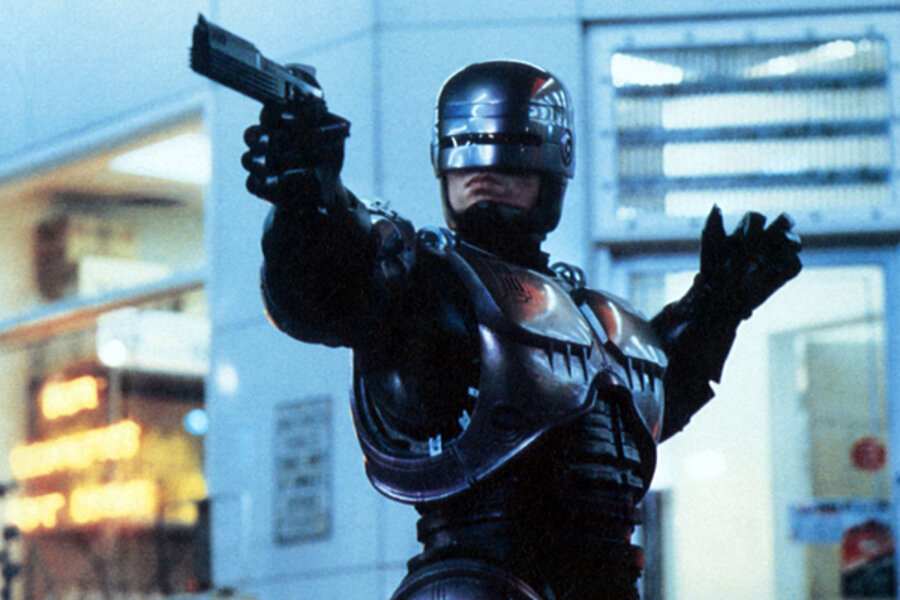Robocop statue: A youthful lift for Detroit or a monument to blight?
Loading...
Old movies can cast a nostalgic glow on just about any setting – even a struggling Rust Belt city such as Detroit.
That’s what a group of youthful idealists say they are hoping to do with a sculpture of, yes, Robocop – the hero of a 1980’s film of the same name in which a cop dies and is reborn as a cyborg in a dystopian Motor City.
It’s been a while since Detroit was mentioned in the same breath as “cool.” But add this idea – and the viral attention it has garnered online – to the moody, super-hip Super Bowl ad fronted by rapper Eminem, and Detroit is, if not exactly “grooving,” at least stepped a bit out of its old rut in the pop-culture imagination.
RELATED: Detroit's next step to combat blight: buy and rehab vacant homes
While these upticks on the zeitgeist meter hardly mean a major turnaround for a city that has suffered record manufacturing and population losses over decades, they do represent something else that has been in short supply around the once- booming home of the American car industry – youthful energy and maybe even a tad of whimsy.
On the other hand, given the negative image of Detroit in the film, observers are mixed on whether or not the Robocop sculpture is a less-than-useful form of “blight chic.”
The idea took off online barely two weeks ago, when the city’s mayor responded to a Twitter inquiry about the sculpture idea. When the mayor’s office tweeted, “There are not any plans to erect a statue to Robocop,” a social media campaign erupted online, raising $25,000 that was then matched by a private donor.
“It just hit a sweet spot,” says Jerry Paffendorf, creative director for Imagination Station, the non-profit that helped organize the fund-raising campaign through its website Kickstarter.
“Detroit usually has this profile of being scary and a place you don’t want to come to,” he says, adding, “but this is just something that makes Detroit feel more welcoming.”
The proposal certainly fits into a trend already well underway in many rustbelt cities – positioning art as a magnet for urban renewal.
“The artist communities bring exactly the kind of young, energetic energy that these cities need,” says Syracuse University pop culture expert Robert Thompson, adding “it’s what many cities from New York’s Soho to New Orleans have done and done well.”
Whenever any city tries to promote itself, it faces a balancing act between the image it wishes to portray and the issues it faces, says La Salle University communications professor Michael Smith.
An “image” is composed of everything we know about a place, filtered through our value systems, he says via email.
“There are many ways that we “know” about a place – news media coverage (including the hapless Detroit Lions), fictional portrayals (the movies, “Robocop” “Grand Torino,” and TV’s “Detroit 187”), messages created by city, spotlight events that draw public and media attention,” he points out.
The real trick – and the reason why the Super Bowl spot struck a chord around Michigan and beyond, he says, “is to tell the story of how the city is trying to claw back.”
The meaning from this comes subtly, he adds, “to the extent that these messages spur conversations about what’s next for Detroit, they’re meaningful.”
To the degree that they sentimentalize and overlook the ravages of displaced workers and manufacturing flight, they are what John McCarthy, a professor of urban history at Robert Morris University in Pittsburgh, calls “Rust Belt chic.”
He maintains that viewing blighted cities as blank slates for outsiders to compose upon – artists or not – is arrogant and undermines genuine progress towards renewal. “I don’t see anything in the Robocop image that is positive for the city of Detroit,” he says, noting that the primary message it sends is at best, “an ironic one.”
RELATED: Detroit's next step to combat blight: buy and rehab vacant homes





